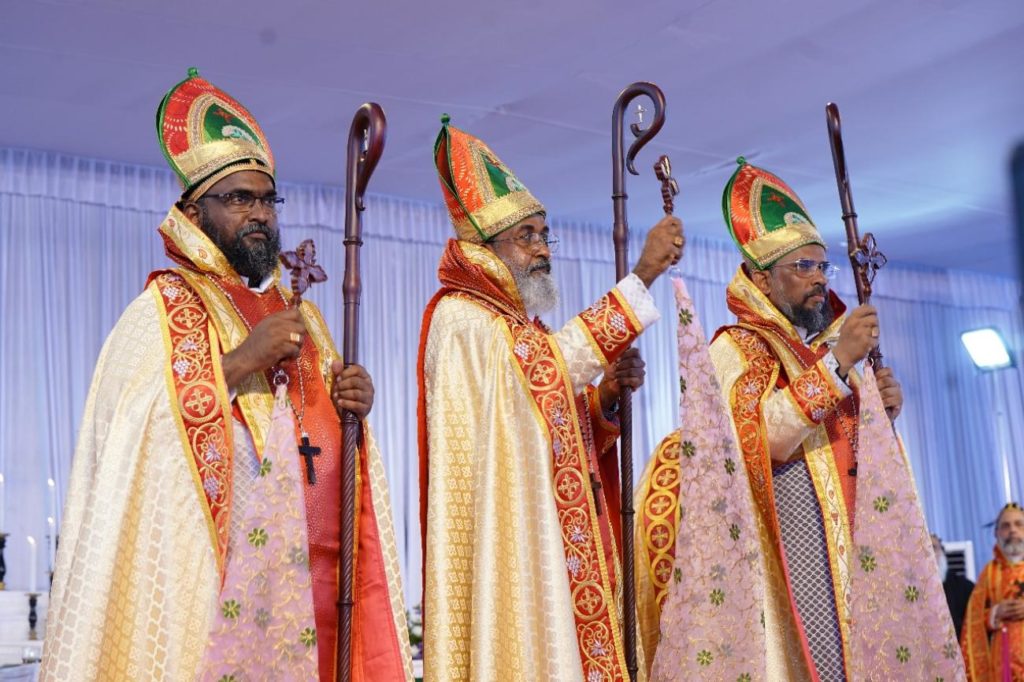Three new bishops for the Mar Thoma Church
The enthusiasm was infectious, when the three new bishops of the Malankara Mar Thoma Syrian Church were consecrated 2 December in Thiruvalla (India). They were: Saju C. Pappachen Ramban, Mathew K. Chandy Ramban and Joseph Daniel Ramban. After his ordination as a priest, the latter continued his theological studies in Bern, at the Institut für Christkatholische Theologie. There he also gained his doctorate. He is a very likeable man, who knows how to rouse people. During his studies he organized two Mar-Thoma parishes in Switzerland, one of which is based in an Old Catholic church building. The long-lasting contact to the Bern Theological Institute and our Swiss sister church were made very evident by the presence of Professor Angela Berlis, who had travelled to India especially for this occasion.
I was present at the ordination as representative of the Union of Utrecht. In view of the signing of the church communion between the Mar Thoma church and the Union of Utrecht, which is planned for February 2024, it felt particularly special, and I was very happy to be there. I was not just welcomed officially, but also the theological dialogue between the two churches was expressly mentioned and praised by Metropolitan in his gratulation speech during the meeting that took place after the ordination. The members of the Commission, Bishop John Okoro and Bishop Harald Rein (as observer), likewise theologians Peter-Ben Smit and Adrian Suter, by the way, also deserve congratulations for their work. It cannot be taken for granted that a western communion of catholic churches achieves church communion with an oriental church. It is impossible without solid theological reflection, which takes a deeper look at the reasons and background of the separation which was already a fact so early in the existence of Christianity. Thus, it is all the more gratifying to be able to bridge more than 1,600 years of separation. Therefore, a union like this is not just a contribution to the ecumenical movement, it is also an incentive for them. It is no coincidence that a challenge like this arose through the Union of Utrecht!
The consecration took about four hours. An accumulation of symbols and at almost every moment a reference to the church of the first centuries. 15,000 believers were present. Gathered under a big canopy, they sang and prayed in unison. Thousands followed the liturgy on huge screens that had been set up here and there in the vicinity. Only a few hours after the ceremony, the number of viewers of the You-Tube broadcast reached a hundred thousand. The vivacity of this church and the commitment of the believers are tangible. However large this church may be, it is a community. Towards the end of the ceremony, the bishop, sitting on a chair, is raised up above the people, to receive their applause. I expressed my congratulations in the name of the Archbishop of Utrecht, the IBC and the entire Old Catholic community, whereby I emphasized the results of the dialogue, but also the almost natural way in which our two communities embraced each other. In the opinions of both communities, it was a meeting which could not remain without consequences. What unites our two communities is not just their link to the church of the first centuries, but also the desire to be close to the reality of their own culture and society. The Mar-Thoma-Church is missionary, not just by means of proclamation, but also, perhaps even more, in their social projects. Christians do not have it easy in India, but that does not mean that the Mar Thoma Church isolate themselves on their own island, where supposedly their safety would be guaranteed. In our secularised context, this kind of isolation is not to be recommended. We are sure to find ideas in this new sister church of how to follow creative paths, in order to serve the proclamation of the gospel in our context too, however different our own tradition may be. I was also amazed, by the way, at how self-evident it was that representatives of both the Hindu and the Muslim communities were present. The Mar-Thoma Church appears to be anything but one-sided!
On the day after the consecration, we witnessed a similarly enthusiastic reception of the new bishop, Joseph Mar Ivanios, in his home village. The whole region was full of posters with his picture, and more than a thousand believers took part in the eucharist, over which he presided. Afterwards there was a so-called ‘congratulation event’, at which I had the honour to hold the main sermon. There I emphasized that the new bishop is a true builder of bridges. This is also reflected in the presence of representatives from the local administration, and both the Muslin and the Hindu communities. All of them emphasized their pride that the new bishop had appeared in their midst. One very special touch, for example, was when classmates from his primary school presented him with a present. They are all Hindu. In reverence of the spiritual leader who had once been their classmate, they each bowed down before him in turn, and touched his feet with their hands. Bishop Joseph Mar Ivanios is an extraordinary man, who could play a big part in the relations between our churches.
Text: Archbishop Emeritus Joris Vercammen
Translation: Rev. Elizabeth Dudley

